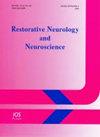Hematopoietic Endothelial Progenitor cells enhance motor function and cortical motor map integrity following cerebral ischemia
IF 1.6
4区 医学
Q4 NEUROSCIENCES
引用次数: 0
Abstract
Hematopoietic stem cells (HSC) are recruited to ischemic areas in the brain and contribute to improved functional outcome in animals. However, little is known regarding the mechanisms of improvement following HSC administration post cerebral ischemia. To better understand how HSC effect post-strokeimprovement, we examined the effect of HSC in ameliorating motor impairment and cortical dysfunction following cerebral ischemia. Methods:Baseline motor performance of male adult rats was established on validated motor tests. Animals were assigned to one of three experimental cohorts: control, stroke, stroke + HSC. One, three and five weeks following a unilateral stroke all animals were tested on motor skills after which intracortical microstimulation was used to derive maps of forelimb movement representations within the motor cortex ipsilateral to the ischemic injury. Results:Stroke + HSC animals significantly outperformed stroke animals on single pellet reaching at weeks 3 and 5 (28±3% and 33±3% versus 11±4% and 17±3%, respectively, p < 0.05 at both time points). Control animals scored 44±1% and 47±1%, respectively. Sunflower seed opening task was significantly improved in the stroke + HSC cohort versus the stroke cohort at week five-post stroke (79±4 and 48±5, respectively, p < 0.05). Furthermore, Stroke + HSC animals had significantly larger forelimb motor maps than animals in the stroke cohort. Overall infarct size did not significantly differ between the two stroked cohorts. Conclusion:These data suggest that post stroke treatment of HSC enhances the functional integrity of residual cortical tissue, which in turn supports improved behavioral outcome, despite no observed reduction in infarct size.造血内皮祖细胞能增强脑缺血后的运动功能和大脑皮层运动图谱的完整性
造血干细胞(HSC)被招募到大脑缺血区域,有助于改善动物的功能预后。然而,人们对脑缺血后给予造血干细胞后的改善机制知之甚少。为了更好地了解造血干细胞如何影响卒中后的功能改善,我们研究了造血干细胞对改善脑缺血后运动障碍和皮层功能障碍的影响。方法:通过有效的运动测试确定雄性成年大鼠的基线运动表现。动物被分为三个实验组:对照组、中风组、中风+造血干细胞组。在单侧中风后一周、三周和五周,对所有动物进行运动技能测试,然后使用皮层内微刺激来绘制缺血性损伤同侧运动皮层内的前肢运动表征图。结果:在第3周和第5周,中风+造血干细胞动物在单个颗粒到达上的表现明显优于中风动物(分别为28±3%和33±3%对11±4%和17±3%,两个时间点的p均为0.05)。对照组动物的得分分别为 44±1% 和 47±1%。在中风后第五周,中风+造血干细胞组动物的葵花籽打开任务比中风组动物有明显改善(分别为79±4和48±5,p <0.05)。此外,中风 + HSC 动物的前肢运动图谱明显大于中风组动物。两组中风动物的总体梗死面积没有明显差异。结论:这些数据表明,中风后使用造血干细胞治疗可增强残余皮质组织的功能完整性,进而改善行为结果,尽管没有观察到梗死面积缩小。
本文章由计算机程序翻译,如有差异,请以英文原文为准。
求助全文
约1分钟内获得全文
求助全文
来源期刊
CiteScore
5.40
自引率
3.60%
发文量
22
审稿时长
>12 weeks
期刊介绍:
This interdisciplinary journal publishes papers relating to the plasticity and response of the nervous system to accidental or experimental injuries and their interventions, transplantation, neurodegenerative disorders and experimental strategies to improve regeneration or functional recovery and rehabilitation. Experimental and clinical research papers adopting fresh conceptual approaches are encouraged. The overriding criteria for publication are novelty, significant experimental or clinical relevance and interest to a multidisciplinary audience. Experiments on un-anesthetized animals should conform with the standards for the use of laboratory animals as established by the Institute of Laboratory Animal Resources, US National Academy of Sciences. Experiments in which paralytic agents are used must be justified. Patient identity should be concealed. All manuscripts are sent out for blind peer review to editorial board members or outside reviewers. Restorative Neurology and Neuroscience is a member of Neuroscience Peer Review Consortium.

 求助内容:
求助内容: 应助结果提醒方式:
应助结果提醒方式:


